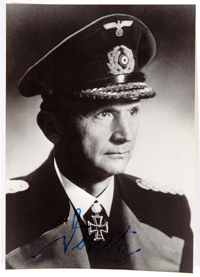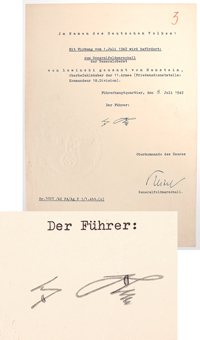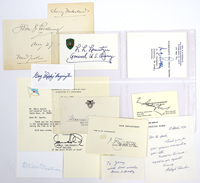
|
Sale 56
Manuscript, Collectibles and Aerospace Auction
| Lot |
Photo |
Description |
Realized |
Lot 258 |
 |
Dõnitz, Karl (1891-1980) German Grand Admiral who built up their submarine fleet and commanded the German navy. He briefly succeeded Hitler, then on May 8, 1945, signed Nazi Germany's unconditional surrender to the Allies. He was convicted of war crimes at Nuremberg and served ten years in Spandau Prison. Photograph signed "Dönitz" at lower edge in blue ink, 5¾ 4 1/8 in., n.p., n.d. A bust portrait in naval uniform. Very fine.
Estimated Value $150 - 200.
View details and enlarged photo
| Realized
$94 |
Lot 259 |
 |
Manstein, Erich von & Wilhelm Keitel - Two Field Marshals (1887-1973) Considered the most brilliant of all of Hitler's 27 Field Marshals. Typed Document Signed "Adolf Hitler," 1 page, in German, 11¾ x 8¼ in., Führer Headquarters, July 5, 1942. The document has a raised official Nazi seal to the lower left of Hitler's signature, 3 inches in diameter. The document is headed "In the name of the German people!" and announces that effective from July 1, 1942, "Colonel General von Lewinski called von Manstein, Commander in Chief of the 11th Army…." is promoted to General Field Marshal. The document is also signed "Keitel" by General Field Marshal Wilhelm Keitel (1882-1946), who was Commander in Chief of the Armed Forces and the unofficial war minister. Very fine.
Born Fritz Erich von Lewinski, Manstein was a professional soldier descended from a line of Prussian generals. One of ten children, his parents (General of Artillery Eduard von Lewinski was his natural father) allowed him to be adopted by his mother's childless sister and her husband, Lt. Gen. Georg von Manstein. Erich followed in the footsteps of his father and uncle and entered the Prussian Army in 1906. He served in World War I, rising to Captain, with an Iron Cross First Class and the Hohenzollern House Order. After the war, he helped create the Reichswehr, the army of the Weimar Republic, which was restricted to 100,000 men. He rose through the Army and in 1939 participated in the invasion of Poland as Chief of Staff, Army Group South. In 1940, it was Manstein who initiated and helped plan the Ardennes offensive which led to the fall of France; for this he was promoted to full general and awarded the Knight's Cross. In February 1941, Manstein was appointed commander of the 56th Panzer Corps and was involved in Operation Barberossa. In September of 1941, he was appointed commander of the 11th Army, whose goals were invading the Crimea and capturing Rostov. He decided to go after the Crimea first and finally, after months of fighting, captured Sevastopol on July 3, 1942. Hitler called Manstein on July 4th and called him "The Conqueror of Sevastopol" and told him that he was being promoted to General Field Marshal, which he was the next day, when Hitler signed this document. Manstein also won a major victory in 1943 when he recaptured Kharkov and stopped the Soviet's winter campaign (Hitler gave him Oak Leaves for his Knight's Cross for this), but on March 30, 1944, Manstein was dismissed by Hitler because of disagreements over military stategy on the Eastern front. Mannstein retired to his estate and fought no more. After the war, he was captured by the British and spent four years in prison before being brought before a British Military court in Hamburg in 1949. He was convicted of one charge: neglecting to protect civilian life, and sentenced to 18 years, later reduced to 12 years. He was released in 1953 on medical parole and served as a military advisor for the West German Army. He wrote his autobiography, Verlorene Siege [Lost Victories] and died at the age of 85.
Field Marshal Keitel was known as "Little Lackey" because of his subservience to Hitler. Although he was against invading France (a plan initiated by Manstein), he did back down and was promoted Field Marshal after the French campaign, then received the Knight's Cross for arranging the armistice with France. Keitel signed orders allowing soldiers to be summarily executed, rather than taken prisoner of war. He was also involved in handing over officers who were involved in the July 20, 1944 plot to assassinate Hitler. On May 8, 1945, Keitel, on orders from Dõnitz, signed an unconditional surrender in Berlin. At Nuremberg, where he was accused of numerous offenses, his response was that he was just following orders. He was sentenced to death and because of his signed orders to execute soldiers, was ordered to be hanged, rather than shot by a firing squad.
Proceeds from the sale of this document will be donated to the Museum of Tolerance.
Estimated Value $15,000 - 20,000.
View details and enlarged photos
| Unsold |
Lot 260 |
 |
McAuliffe, General Anthony C (1898-1975) American soldier and West Point graduate. He fought in World War I, World War II, and the Korean War. He is famous for the most famous quote from World War II: "Nuts!" Autograph Letter Signed "A C McAuliffe," 1 1/3 pp (Washington, DC), Feb. 20, 1975. Written less than six months before McAuliffe's death to a young man, Mr. Jonathan Cross, in Philadelphia, explaining the circumstances during the Battle of the Bulge which led to his famous quote. In full:
"Dear Jonathan: The best answers to your questions are contained in the many histories that are available, like 'Battle: The Story of the Bulge' by John Toland. I commanded the 101st Airborne Division and attached troops, a force of about 20,000, charged with defense of the key road center of Bastogne. We were quickly surrounded and cut off by the Germans. Their commander sent me a written demand to surrender, saying our situation was hopeless. The Germans asked for a written reply, so I gave them one: 'Nuts.' I was disgusted and was sure we could hold out until General Patton's Army broke through to us. This we did. Sincerely, A. C. McAuliffe." Very fine. Accompanied by the transmittal envelope, addressed in McAuliffe's hand.
The Battle of the Bulge (Dec. 16, 1944-Jan. 25, 1945), called Unternehmen Wacht am Rhein by the Germans and the Ardennes-Alsace campaign by the U.S. Army, but now more commonly know as the Battle of the Bulge, was Germany's last, desperate offensive of the war. It was also the largest land battle of World War II in which American forces took part. Hitler planned to take Allied forces by surprise by attacking a weakly-defended area in the Ardennes mountain range during bad weather, when Allied aircraft could not be deployed, and to push through to the harbor at Antwerp. He hoped to divide British and American forces, whose generals were known to bicker, and to force them to sue for a separate peace from the one the Germans would have to sign with the Soviets; this would give the Germans more time to churn out more war materiel.
The town of Bastogne was vital to the Germans, as all seven roads in the Ardennes mountains converged on the town. By noon of Dec. 21st, they had surrounded Bastogne and on the 22nd, the German commander, Generalleutnant Heinrich Freiherr von Lüttwitz, sent a written demand for surrender in order to avoid "total annihilation." McAuliffe, who was in command only because Gen. Maxwell Taylor was elsewhere, didn't hesitate, even though most of his medical supplies and personnel had been captured and artillery ammunition was restricted to ten rounds per gun per day. McAuliffe's gutsy reply to the Germans raised the morale of Allied troops everywhere when word got out. His faith in Patton was justified, too; Old Blood and Guts showed up with his Third Army the day after Christmas, bringing much-needed relief.
More than 1,000,000 men fought in the Battle of the Bulge: some 600,000 Germans, 500,000 Americans, and 55,000 British. American casualties were approximately 80,000, wih 19,000 killed; British casualties were 1400, with 200 killed; and Germans killed, wounded, or captured amounted to 100,000.
After the Battle of the Bulge, McAuliffe was given command of the 103rd Infantry Division of the US 7th Army, which he led from January 15, 1945 to July, 1945. For his actions at Bastogne, he was awarded the Distinguished Service Cross by General Patton on Dec. 30, 1944, and later received the Distinguished Service Medal.
Without question the most important World War II letter we have handled. It could realize a runaway price.
Estimated Value $20,000 - 25,000.
View details and enlarged photo
| Realized
$14,160 |
Lot 261 |
 |
[Eleven Generals From World I Through the Gulf War, An Admiral & Others]. Group of 17 items, 15 of them signed: John J. Pershing on 5 x 7 in. toned paper, Aug. 27, 1930, New York, with a card printed "General Pershing and "Christmas Greetings" in another hand; George C. Marshall on engraved autograph card as Chief of Staff, U.S. Army; Omar N. Bradley on 2 x 3¼ in. paper, inscribed "To Jerry with best wishes"; Nathan F. Twining on the back of his Carlton Club (DC) membership card, with "Gen USAF (Ret.)"; Matthew B. Ridgway on 4½ x 3½ memo paper, as General, US Army, Retired; Arleigh Burke an Autograph Note Signed (as retired admiral) on engraved notepaper, Mar. 17, 1976; L.L. Lemnitzer as "Gerneral, U.S. Army," on card with SHAPE emblem, and a 1978 Typed Letter Signed as Retired General giving Gen. Alexander Haig's address; W. C. Westmoreland on a blank white card; Maxwell D. Taylor on card engraved "Major General, U.S. Army / superintendent, U.S.M.A." and with U.S.M.A. emblem; H. Norman Schwarzkopf on engraved card as General, U.S. Army, Retired; John M. Shalikashvili 1994 Typed Letter Signed as Chairman of the Joint Chiefs of Staff, enclosing an autograph card (not present). Also, a card signed by "Greg 'Pappy' Boyington," commander of the "Black Sheep Squadron"; a card signed by Charles W. Lindberg, one of the U.S. marines who raised the smaller, first flag on Iwo Jima; and a card signed by Anna C. Chennault, widow of Flying Tigers' commander Claire Channault, plus an unsigned card of hers engraved in English and Chinese.
Estimated Value $600 - 800.
Harry Sparks collection.
View details and enlarged photo
| Realized
$192 |
Lot 262 |
 |
[Enola Gay]. Six cards signed by members of the crew of the Enola Gay, the B-29 Superfortress bomber that dropped the first atomic bomb on Hiroshima, Japan on August 6, 1945: Paul W. Tibbets, pilot (2); George Caron, tailgunner; Thomas Ferebee, bombadier; Jacob Beser, radar specialist; and Richard H. Nelson, radio man. All fine.
Estimated Value $250 - 300.
Harry Sparks collection.
View details and enlarged photo
| Realized
$118 |
|
|